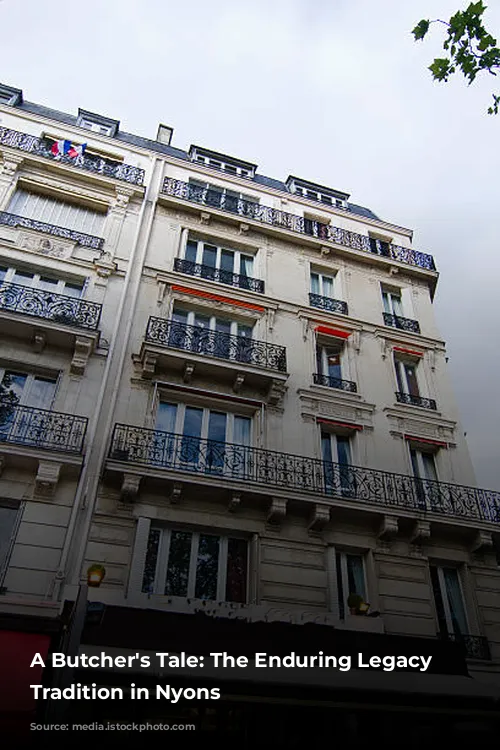It’s not every day you meet a butcher who’s a bit of a philosopher. Cyril Usclat, the proprietor of the Boucherie Charcuterie Usclat in Nyons, sums up his craft with a humorous declaration: “Every bit of the pig is good, just like the boss!”

A Shop Steeped in History
Usclat’s shop, nestled in the 14th-century Place du Docteur Bourdongle, is a charming sight. The walls are adorned with delightful murals featuring animals, verdant fields, and the iconic Pont Roman. The warm welcome you receive, whether you’re buying a simple slice of jambon or a €200 feast, is as much a part of the experience as the enticing smells of charcuterie.
A Flying Pig?
Outside, on the ceiling, artist Luc Mazan has painted a whimsical scene of pigs flying against a backdrop of fluffy clouds. While English-speakers might interpret this as a playful reference to the phrase “When pigs fly,” Béatrice Usclat, Cyril’s wife and co-worker, chuckles at the suggestion. “Quand les poules auront des dents” (“when chickens will have teeth”), the French equivalent, is much more familiar to them. The flying pigs are simply one of Cyril’s many imaginative ideas.
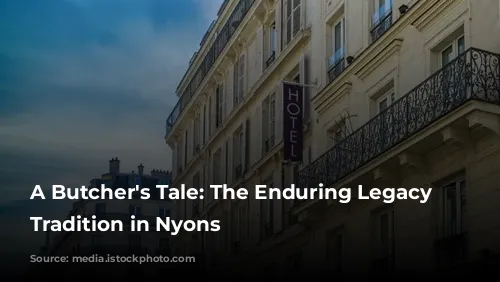
A Vanishing Craft
The number of boucherie/charcuteries in Nyons tells a tale of dwindling traditions. In the 1950s, seven butchers served a population of 3,600. Today, only two remain, a reflection of a national trend. After World War II, France boasted 40,000 butchers. This number has shrunk to under 20,000, despite a population increase of millions.
The Challenges of Tradition
The declining numbers are attributed to various factors. The strained economy, the rise of hypermarkets, and the decline in traditional home cooking have all taken their toll. But perhaps the biggest challenge is the long hours that butchers work. In a country where the 35-hour workweek reigns supreme, the long days put in by butchers are not attractive.
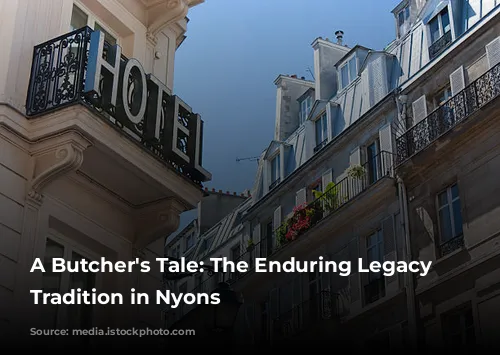
A Labor of Love
Cyril Usclat, however, remains dedicated. He still works up to 80 hours a week, a testament to his passion for his craft. He began his apprenticeship at the age of 15, and then spent three more years studying to earn five different certificates in the art and practice of butchery and charcuterie. Usclat and his staff of two butchers are part of a vanishing breed. They still speak loucherbem, the traditional argot used by butchers when they’re “talking shop.”
A Family Affair
Usclat’s shop is a testament to the longevity of tradition. He purchased the business in 2006 from Guy Dinelle, another Nyonsais, for whom he had worked for 22 years. Rachida, a local Tunisian widow, has been cleaning the shop twice a day for 20 years. Béatrice serves behind the counter and handles the paperwork. The shop itself has been home to a butcher since around 1800.

The Art of Charcuterie
The art of charcuterie, which dates back 6,000 years, became popular during the Roman Empire. In France, by the Middle Ages, it had evolved into a highly refined art for the preparation and vending of cooked food, mainly pork. The word itself, charcuterie, comes from chair (meat or flesh) and cuite (cooked).
A Fight for Survival
Initially, charcutiers didn’t have the right to slaughter and had to buy whatever they could from butchers, who didn’t sell them the choicest cuts. Competition was fierce. Even though the charcutiers formed a guild in the 15th century, they didn’t obtain the exclusive right to prepare and cure pigs and their innards until 1741. Today, boucheries and charcuteries are combined, with slaughtering performed only in tightly regulated abattoirs.

A Commitment to Quality
Usclat’s poultry and meat come from individuals and firms that practice humane raising and slaughtering. The Usclats are animal lovers who support the FBB (Fondation Brigitte Bardot) animal rights organisation. When they entertain, Cyril cooks, while Béatrice learned her culinary skills from her mother. They both lament the rise of fast, processed food, believing that cooking is an essential part of French patrimoine and culture.
A Loyal Clientele
Usclat’s clientele has changed over the years. Today, his customers are older, hard-working folk who enjoy eating well. The shop’s two comfortable chairs are reserved for les vieux, the older people who, rich or poor, still buy from an artisanal butcher.
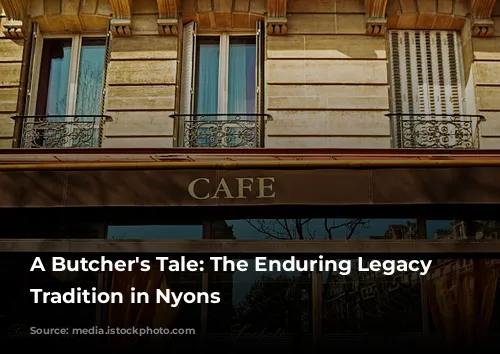
A Ritual of Tradition
On public holidays and weekends, the line outside the Boucherie Charcuterie Usclat stretches around the outdoor rotisserie, where Marie Hot chickens from the Landes roast to a delicious golden brown, filling the arcade with their mouthwatering aroma.
More Than Just a Butcher
French people are deeply loyal to their butchers. To change butchers is almost unthinkable. A butcher is more than a mere commerçant; he’s a confidant, advisor, culinary guru, and friend. Tell him your in-laws are coming for dinner, and he knows the whole story. He’ll know that they are Parisian and fussy, and that they don’t approve of a working daughter-in-law who’s Provençale and a quarter Corsican. Consequently, the roast must be the best there is, exquisitely tied, larded, and prepared. He’ll even share his secret recipe.

Facing Modernity
Today, Usclat sells less abats (offal) than he used to, as the younger generation simply doesn’t know how to prepare it. His best-sellers are lamb and beef. Provence is renowned for its sweet and tender agneau (lamb). He has the right to sell roasted chickens for three days, then they’re given to three chasseurs (hunters), who come daily for the leftovers and the bones, which they give to their dogs. Everything is strictly regulated by the government. Chickens must be slaughtered at the age of 130-140 days; beef must be less than 36 months old; lamb between 100 days and 3.5 months; and veal less than eight months. Even so, Usclat’s level of wastage is low, at around seven per cent, most of which is unsold offal.

A Culinary Treasure Trove
Part of Usclat’s trade consists of plats cuisinés (ready-to-eat dishes), most of which are prepared in the shop’s basement kitchen. These include bouchées à la Reine, a type of vol-au-vent made with sweetbreads; daube Provençale, a classic regional stew; stuffed vegetables and gratins; celéri Rémoulade; salade museau de boeuf, an ox-head salad; caillettes; rillettes; pâtés and terrines; saucissons secs (dried) and cuites (cooked); and every Friday, an enormous choucroute. At Christmas and Easter, he sells foie gras cru (raw) and cuite from vendors who do gavage humanely, by hand.

The Enduring Appeal of the Butcher
Butchers are central figures in the French mind and imagination. They’ve appeared in folklore as bogeymen, used to frighten children into good behavior. They’ve also been portrayed as figures of wealth, power, good cheer, and sexual prowess.

A Shifting Landscape
In a rapidly changing society, their role and status are in flux. Will the small, independent, quality boucheries/charcuteries continue to decline, or could there be a backlash against the industrial and semi-industrial food production that now prevails and is powerfully regulated by the European Community?

The Passing of an Era
The shift away from traditional butcher shops has been gradual but steady. Some causes have been obvious and dramatic, while others have gone largely unnoticed. One notable tipping point occurred on the morning of March 1, 1969, when the first of the pavilions at Paris’s famed Les Halles market began to be emptied, for the move to the Rungis industrial park south of the capital.
The Heart of Paris
Les Halles had been, as Zola aptly called it, “le ventre de Paris” (“the belly of Paris”), and most of the capital’s food supply flowed through the market. Hundreds of bistros surrounded Les Halles, catering to those who worked and traded there.
A Lost Camaraderie
The area boasted an intimacy – a camaraderie of cooking, drinking, and eating – that is the stuff of legend. I remember visiting Les Halles at 3am in 1963 and being overwhelmed by the swirling colors, fragrances, and sounds. At dawn, we fought our way into a bistro for steaming soupe à l’oignon, the panoply of packed humanity laughing and shouting around us.
A Shift in Culture
Butchers entered with the choicest cuts, taking them into the kitchen and supervising their preparation while they swigged wine and downed shots of cognac. In contrast, the workers at Rungis now arrive with packed lunches, eat quickly, and leave – it’s all business. With the death of Les Halles, a whole way of life came to an end, and the reverberations were felt across France.
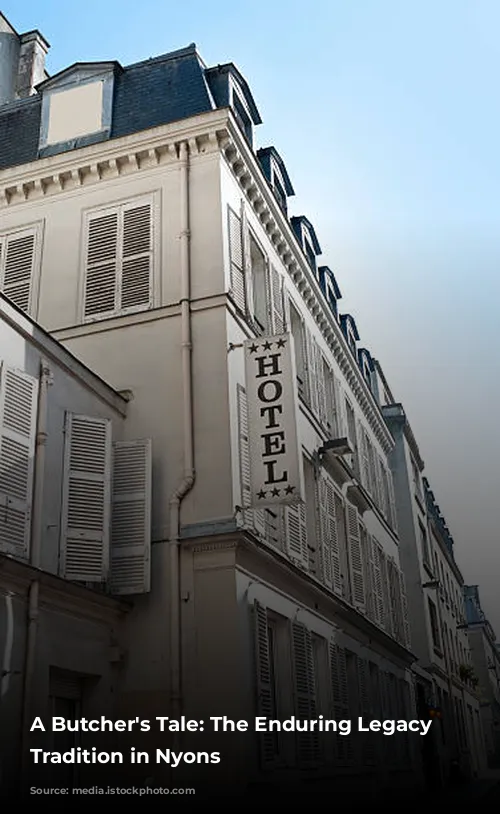
The End of a Tradition
On July 2, 1971, a nationwide arrêté municipale put an end to a centuries-old tradition known as le jour du cochon, la tuade or le tue-cochon – the festive slaughter of a fatted pig and the preparation of its carcass, from nose to tail, to sustain the participants throughout the year.
A Loss of Value
Industrialization supposedly has benefitted humanity by ushering in fewer working hours, lower prices, and higher profits. But something incalculably precious has been lost. As I age, I eat less meat, but when I do, I consider myself blessed to be able to stroll into Usclat and buy food that I know isn’t only ethically raised and slaughtered but is also guaranteed to be absolutely delicious.
Want to discover the real Provence? Join France Today on our luxurious yet intimate tours of Provence

